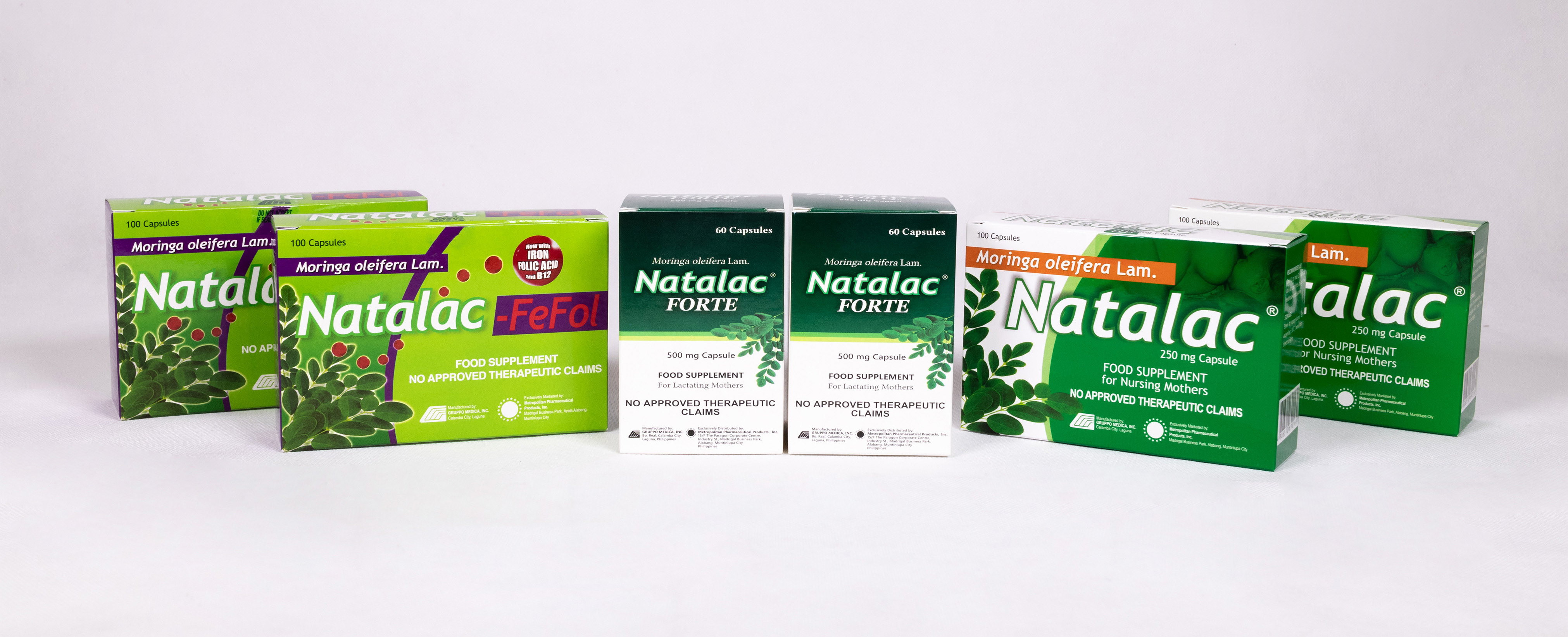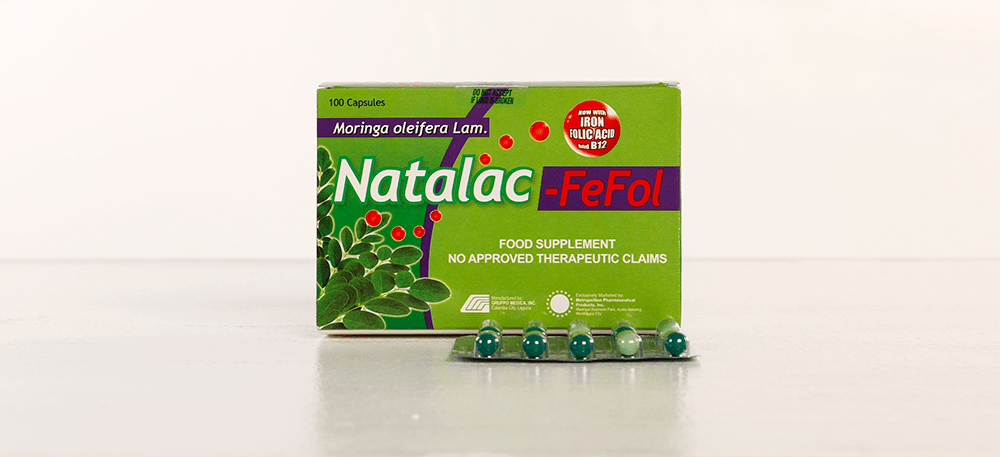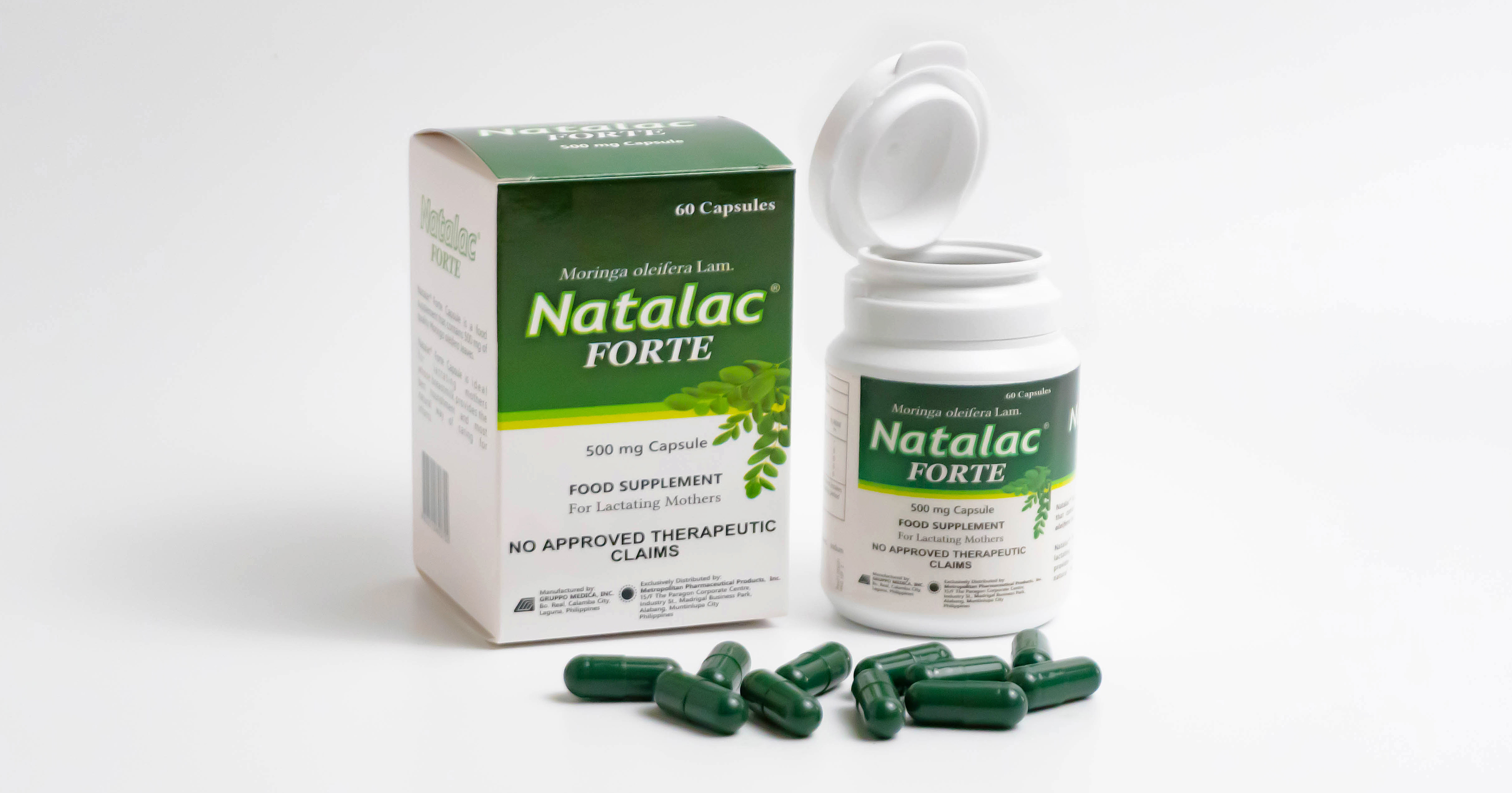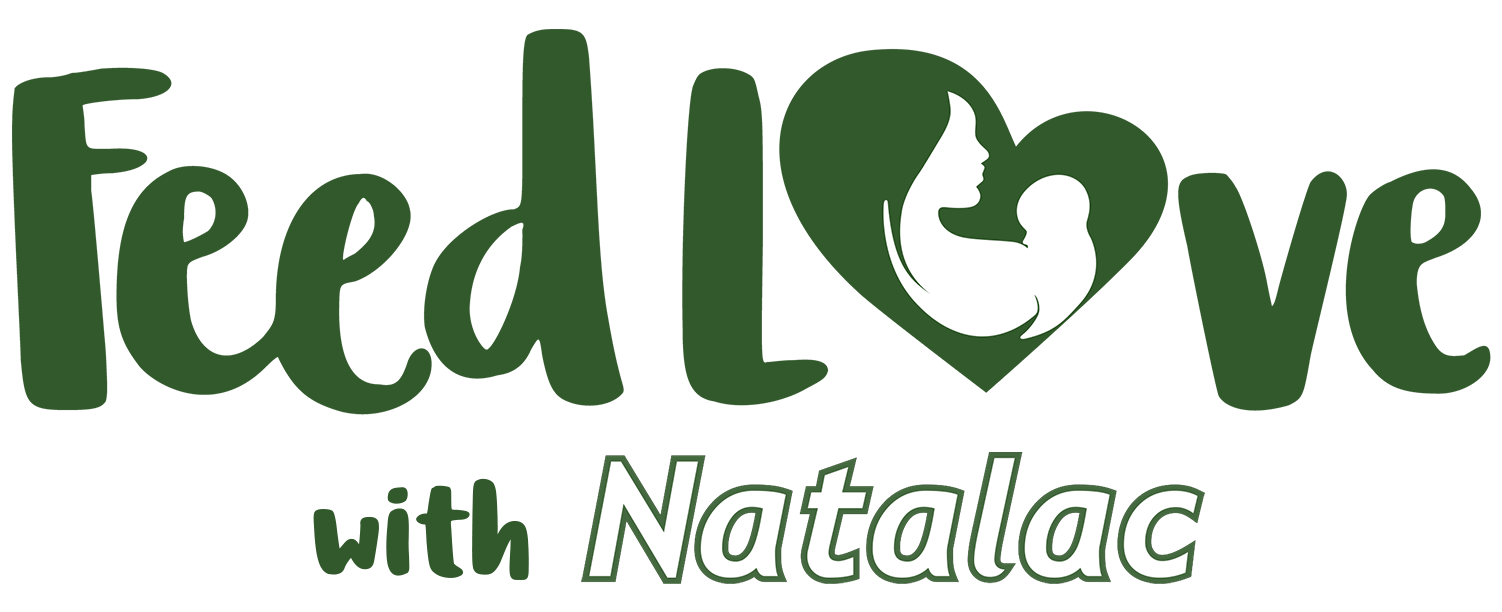Prescribed by Doctors, Trusted by Mothers.
NATALAC® is the FIRST clinically-proven effective lactation enhancer containing young malunggay leaves, which come from selected high-quality, healthy, organically grown and chemical-free malunggay trees. It is rich in iron, calcium, phosphorus, Vitamins A and C, and proteins that help increase mother’s breastmilk volume.
NATALAC® can be taken by both normotensive and hypertensive mothers, and can enhance milk let down for mothers who underwent either normal and caesarian delivery.
NATALAC® is manufactured in a GMP-certified laboratory, and has been tested to be free from both pesticides and heavy metals.

Not all Malunggay Preparations are the same
We ensure that only high quality malunggay leaves are processed and used in Natalac Capsule.
Harvest
- From the harvest, only high quality malunggay plants and leaves are selected
- Fresh, quality young malunggay leaves are manually harvested from pesticide-free and chemical-free plants
- The trees are planted away from the highway or roads to guarantee the absence of toxins and heavy metals
Processing
- Only leaves are processed; extraneous matters such as other unnecessary plant parts (twigs and stems) are removed thru careful garbling
- Thoroughly washed and processed using Purified water (not just ordinary tap water) to avoid chemical contamination
- Leaves are dried under controlled and monitored temperature with a prescribed drying time to preserve the nutritive value of the leaves.
- The drying method is validated to protect the leaves from oxidation and other chemical reaction and to retain the leaves’ natural color
- Moisture content is controlled to avoid bacterial, molds and yeast growth
- The leaves are milled using pharmaceutical-grade stainless steel which is non-reactive and non-corrosive to maintain the quality of the malunggay leaves and powder
Manufacturing
- Manufactured by a GMP-certified laboratory
- Each manufacturing step is monitored to ensure that all specifications are met and passes the quality standard from compounding to encapsulation to blistering to packaging and then warehousing.
- All raw materials used in the production are pharmaceutical grade that conform to pharmacopoeial standards and these raw materials have passed the stringent Quality Control tests.
Transforming the Malunggay Miracle to Natalac
Prescribed by Doctors, Trusted by Mothers.
A world-class manufacturing process. All it takes is a three-step manufacturing process to capture the goodness of malunggay in one capsule.
- Step 1. Discriminating leaf selection to start production. For NATALAC®, Gruppo Medica, the manufacturing arm of the Meneses Group of Companies, only uses young high-quality malunggay leaves from healthy, disease-free, organically-grown and chemical- and pesticide- free malunggay trees.
- Step 2. An exclusive washing and cleaning procedure. Gruppo Medica ensures that each NATALAC® capsule is an end-product free from contamination and with ultra-low bacterial counts way below allowable amounts.
- Step 3. A hygienic air drying procedure. Malunggay’s nutritive value is lost when heat is applied for drying. Gruppo Medica uses a hygienic air drying procedure instead that ensures to keep the nutritive value of young malunggay leaves intact in each NATALAC® capsule.
The end-result? NATALAC® capsule, with the right amount of malunggay you need. While other brands contain higher content of malunggay, NATALAC’s world class manufacturing process ensures to keep the nutritive value of selected young high-quality malunggay leaves intact in each 250 mg Moringa oleifera capsule making sure you get the suffecient amount of malunggay you need from NATALAC®.
Growing the Vegetable Malunggay
Megadiverse Philippines. In the world, the Philippines is considered one of the 17 megadiverse countries. Note that a country is considered megadiverse if it counts among the world’s top biodiversity-rich countries. Biodiversity, to borrow from Merriam-Webster, means biological diversity in an environment, as indicated by numbers of different species of plants and animals.
The world’s megadiverse countries—one of which we call home—host two-thirds of the Earth’s biodiversity and contain about 70 to 80 percent of the world’s plant and animal species.
Be proud—the Philippines ranks fifth in terms of number of plant species. It is the habitat of one to five percent of the world’s plants (about 10,000 to 13,000 species of plants described and recorded). Malunggay—ideal to grow practically anywhere. An ideal tree to grow in the city or country is malunggay, also known as Moringa oleifera. You can almost always make space for a malunggay tree. If you have no space at all to grow your own tree, see if you can get your neighbors’ help to grow malunggay trees on common ground such as the roadside, beside a playground, or even around a garbage dump.
The soft foliage and large bunches of malunggay’s scented white flowers will beautify the surroundings. After the petals fall from its blossoms, the pods form next, and can be harvested over several months of the year.
The malunggay tree needs lots of water to grow but doesn’t like to be drowned in it. The best place to plant it is adjacent to a water drainage channel where malunggay roots can access the water but do not stand in it. Malunggay may even be planted where waste water from the kitchen can run past it. This way, this water is put to good use before being left to dry or to flow elsewhere, with no extra water is needed for the tree.
Malunggay thrives in sandy soil but will also grow in most well-drained soils. Avoid, however, stiff clay soils which can get it waterlogged.
Also avoid dry, shallow soils, which could stunt it. When its roots have set, however, malunggay can survive severe drought.
Getting Nutrition from Malunggay
Versatile malunggay will yield food, fodder, fuelwood and shade. Its pods will give you a tasty, nutritious vegetable product—or viand. You can eat its tender leaves and flowers too. The leaves also make excellent livestock feed. Best of all, this useful tree grows quickly and easily in many different climes.
Harvesting malunggay pods as food. Use the green pods as a vegetable. Pick the pods when they are plump and firm but still tender. Cut them into pieces that are five centimeters long. Steam lightly. Eat the soft flesh and seeds inside and discard or compost the fibrous outer skin. Malunggay is delicious cooked with spices and mixed with other vegetables such as eggplant or legumes. Malunggay pods are staples in vaunted Ilocano cooking.
Eating malunggay leaves. You can also cook the young flowers and tender leaves of the tree. Be sure to dry them completely after washing. Cover and cook the leaves and flowers in their own juices. If you add water to cook the leaves, they turn bitter.
Reaping enormous benefits. Make malunggay a part of your regular diet. It contains many good nutrients. For example, gram for gram, malunggay leaves contain:
- 7 times the vitamin C in oranges
- 4 times the calcium in milk
- 4 times the vitamin A in carrots
- 2 times the protein in milk and yogurt
- 3 times the potassium in bananas
Malunggay’s medicinal properties. Rich in antioxidants, malunggay is an outstanding indigenous source of natural phytonutrients with these properties, which are supported by voluminous studies:
- Antibiotic
- Hypotensive
- Antispasmodic
- Anti-ulcer
- Anti-inflammatory
- Anti-cancer
- Hypocholesterolemic
- Hypoglycemic
Malunggay’s chemical analysis. Each 100 grams of dried malunggay leaf powder is packed with the following nutrients:
- Moisture % 7.5
- Calories 205
- Protein (g) 27.1
- Fat (g) 2.3
- Carbohydrate (g) 38.2
- Fiber (g) 19.2
- Calcium (mg) 2003
- Manganese (mg) 368
- Phosphorus (mg) 204
- Potassium (mg) 1324
- Copper (mg) 0.57
- Iron (mg) 28.2
- Sulfur (mg) 870
- Oxalic acid (mg) 1.6%
- Vitamin A – β-carotene (mg) 16.3
- Vitamin B1 – thiamine (mg) 2.64
- Vitamin B2 – riboflavin (mg) 20.5
- Vitamin B3 – nicotinic acid (mg) 17.3
- Vitamin C – ascorbic acid (mg) 17.3
- Vitamin E – tocopherol acetate (mg) 113
- Arginine (g/16gN) 1.33%
- Histidine (g/16gN) 0.61%
- Lysine (g/16gN) 1.32%
- Tryptophan (g/16gN) 0.43%
- Phenylalanine (g/16gN) 1.39%
- Methionine (g/16gN) 0.35%
- Threonine (g/16gN) 1.19%
- Leucine (g/16gN) 1.95%
- Isoleucine (g/16gN) 0.83%
- Valine (g/16gN) 1.06%
How Does Natalac Keep Mother’s Milk Flowing?
Resorting to galactogogues, or lactation enhancers. Galactogogues are substances that enhance a mother’s breast milk production. Known elsewhere in the world to stimulate and enhance breast milk production are metoclopramide, domperidone, chlorpromazine, fenugreek, milk thistle, alfalfa and other substances. Here in the Philippines, malunggay or moringa oleifera has been a folkloric standout, cited by herbal advocates as a natural enhancer of breast milk production.
Proving Natalac as galactogogue. Moving beyond anecdotal evidence, three pioneering clinical studies show that NATALAC® specifically promotes lactation by increasing serum prolactin which helps women produce breastmilk after child birth. Mothers on NATALAC® produce higher breastmilk volume and their infants show appreciable weight gain.
In 1996, two studies on NATALAC® capsules done by Drs. Almirante & Lim reported an increase in maternal serum prolactin level with its use.
- Effectiveness of NATALAC® as Galactagogue. This study was conducted in Barangay Del Remedio, San Pablo City, with 116 normal term pregnant women as subjects from November 1994 to September 1995.Main result? NATALAC® is a galactogogue (Galactogogue means “lactation enhancer”) and has proven efficacy to enhance lactation among breastfeeding mothers. There is breast engorgement occurrence after 24 hours of NATALAC® intake.
- Enhancement of Breastfeeding among Hypertensive Mothers. This second study was done in the Perinatal Center of the Philippine Children’s Medical Center with 30 hypertensive pregnant patients as subjects from November 1994 to May 1995.Main result? NATALAC® is a galactogogue and has proven efficacy to enhance lactation among hypertensive mothers.
A third study was conducted in 2000 by Drs. Estrella and Mantaring in the Department of Pediatrics, UP-PGH with 68 post-partum mothers of pre-term infants as its subjects.
- A Double-Blind, Randomized Controlled Trial on the Use of Malunggay (Moringa oleifera) for the Augmentation of the Volume of Breastmilk Among Non-Nursing Mothers of Preterm Infants
Main result? NATALAC® increased the volume of breastmilk produced by mothers of preterm infants on post-partum days.
Besides validating earlier folkloric claims about malunggay’s lactation-enhancing properties, these three scientific studies proved beyond doubt that malunggay leads to significantly higher maternal serum prolactin levels, earlier milk let-down and greater milk volume.
What is most reassuring is that the all-natural and organic malunggay in NATALAC® has been proven safe and does not contain toxic components. Before even being transformed to capsule form, malunggay leaves have been used by generations of nursing mothers, especially those with inadequate lactation.
Besides stimulating the secretion and flow of mother’s milk, malunggay is renowned for being an excellent source of nutrition. Promoted as a natural energy booster, it has gained acceptance as a health food supplement.
Using the “Other” Natalac – Natalac FeFol Capsule

NATALAC-FeFol supports extended breastfeeding. Beyond the mandatory six months period set by the Department of Health, mothers could extend breastfeeding indefinitely. They could continue to do this even while their babies are already taking in complementary foods. They would need NATALAC-FeFol to do this effectively.
NATALAC-FeFol supplies the same nutritive value of 250 mg malunggay that regular NATALAC® Capsule contains. Beyond this, NATALAC-FeFol supplies Mom and Baby with Iron (27 mg), Folic Acid (450 mcg), and Vitamin B12 (4.2 mcg)—nutrition usually prescribed by pediatricians as supplements for babies while breastfeeding.
Why add Iron, Folic Acid, and Vitamin B12 to Malunggay?
- IRON, 27 mg in Natalac-FeFol. Breastfed infants require iron supplement at 4 months of age, to prevent imbalances of neurotransmitters that affect cognitive development. Mothers who intend to breastfeed should receive at least 20 mg iron daily from week 20 of pregnancy. This will prevent Iron Deficiency Anemia (IDA) or, at the very least, iron deficiency.
- FOLIC ACID, 450 mcg in Natalac-FeFol. Breast milk raises baby’s folic acid levels, which supports red blood cell production, besides rapid cell division and growth. To effect the transfer of folic acid via breast milk, breastfeeding mothers require a minimum of 250 mg of folic acid daily.
- VITAMIN B12, 4.2 mcg in Natalac-FeFol. Breastfed infants require vitamin B12 supplementation 4 months after birth to prevent a slowdown of physical and mental development, and irreversible nerve damage. Breastfeeding mothers need at least 2.8 mcg of vitamin B12 daily—to pass along to their babies.
NATALAC-FeFol Extends Breastfeeding Benefits
NATALAC-FeFol supplies you and your baby with Iron (27 mg), Folic Acid (450 mcg), and Vitamin B12 (4.2 mcg) altogether with the same nutritive value of 250 mg malunggay in NATALAC® plain. Why is Iron, Folic Acid, and Vitamin B12 needed by breastfeeding mothers and their babies?
IRON Breastfed infants require iron supplement at 4 months of age, to prevent imbalances of neurotransmitters that affect cognitive development.
Mothers who intend to breastfeed should receive at least 20 mg iron daily from week 20 of pregnancy to prevent IDA and iron deficiency.
FOLIC ACID Breastmilk raises baby’s folic acid levels, which supports red blood cell production, besides rapid cell division and growth. Breastfeeding mothers require a minimum of 250 mg of folic acid daily.
VITAMIN B12 Breastfed infants require vitamin B12 supplementation 4 months after birth to prevent a slowdown of physical and mental development, and irreversible nerve damage.
Breastfeeding mothers need at least 2.8 mcg of vitamin B12 daily.
NATALAC-FeFol FAQs
1. What other benefits do I get from NATALAC®?
NATALAC® is a clinically proven lactation enhancer which helps breastfeeding mothers increase their milk supply. Since it’s made from malunggay, you get the added benefits of vitamin A, calcium, vitamin C and more! Take NATALAC-FeFol for added iron, folic acid, and vitamin B12.
2. When do I take NATALAC-FeFol?
It is recommended to start with NATALAC® 2 weeks prior delivery date the switch to NATALAC-FeFol after delivery and continue indefinitely to support breastfeeding nutrition.
3. How do I take NATALAC-FeFol?
Recommended dose is 1 capsule daily or as recommended by health professional.
4. Can I take NATALAC® and NATALAC-FeFol without prescription?
Yes, you may get NATALAC® and NATALAC-FeFol over the counter without prescription since it’s a food supplement and not a drug.
Introducing the new Natalac Forte 500mg

The classic 250mg Moringa capsule moving up to 500mg—double the strength for optimum benefits.
Fully supported and certified by three double-blind randomized clinical trials, the Natalac 250mg alone is proven effective as a lactation enhancer. Natalac Forte 500mg only doubles the benefits you can get from the classic Natalac 250mg miracle vegetable malunggay in a capsule. Now more convenient with a recommended use of one (1) capsule daily, Natalac Forte comes in a bottle of 60 capsules and is more affordable!* With all the edge and standards Natalac has from selecting young high-quality malunggay leaves to its world-class manufacturing process, Natalac Forte 500mg ensures all the nutritive values a breastfeeding mother needs are intact in each capsule to keep mothers’ milk flowing even more!
* As compared to Natalac 250mg
References
- Unilab’s Sekaya steps up health R&D through S&T
- Malunggay (Moringa oleifera) Production Guide
- Fuglie, Lowell J. 1999. The Miracle Tree – Moring oleifera: Natural Nutrition for the Tropics.
- Dr. Lydia M. Marero. 2004. Moringa’s Healing Power for People and Animals. Food and Nutrition Research Institute (FNRI), Department of Science and Technology, Philippines.
- Yabes-Almirante, Corazon MD and Lim, Catherine Hui Tiin N., MD. 1996. Effectiveness of Natalac as a Galactagogue. JPMA Jan-March 1996 71:30:265-272.
- Yabes-Almirante, Corazon MD and Lim, Catherine Hui Tiin N., MD. 1996. Enhancement of Breastfeeding among Hypertensive Mothers. Elsevier Science B.V. Increasingly Safe and Successful Pregnancies. 279-286. 1996.
- Estrella, Ma. Corazon P., Mantaring Jacinto Blas V. III, et al. 2000. A Double-Blind, Randomized Controlled Trial on the Use of Malunggay (Moringa oleifera) for the Augmentation of the Volume of Breastmilk Among Non-Nursing Mothers of Preterm Infants, Phil. Journal of Pediatrics, Jan-Mar 2000; 49(1): 3-6
- Hulthen, L. 2003. Iron deficiency and cognition, Scandinavian Journal of Nutrition 2003; 47 (3): 152-156
- Johnson, D. 2010. First AAP recommendations on iron supplementation include directive on universal screening, AAP Gateway, October 5, 2010
- Makrides, M, et al. 2003. Efficacy and tolerability of low-dose iron supplements during pregnancy: a randomized controlled trial, Am J Clin Nutr 78:145–53.
- Molloy, A, et al. 2008. Effects of folate and vitamin B12 deficiencies during pregnancy on fetal, infant, and child development, Food and Nutrition Bulletin, Vol. 29, No. 2 (Supplement), The United Nations University
- Stamm, R. et al. 2013. Nutrient Intake Values for Folate during Pregnancy and Lactation Vary Widely around the World, Nutrients 5, 3920-3947
- Fedders, L. 2013. Exclusive breastfeeding may cause B12 deficiency in babies, Science Nordic
- Roumeliotis, N. et al. 2012. Vitamin B12 deficiency in infants secondary to maternal causes. Canadian Medical Association Journal, October 2, 2012, 184(14)

